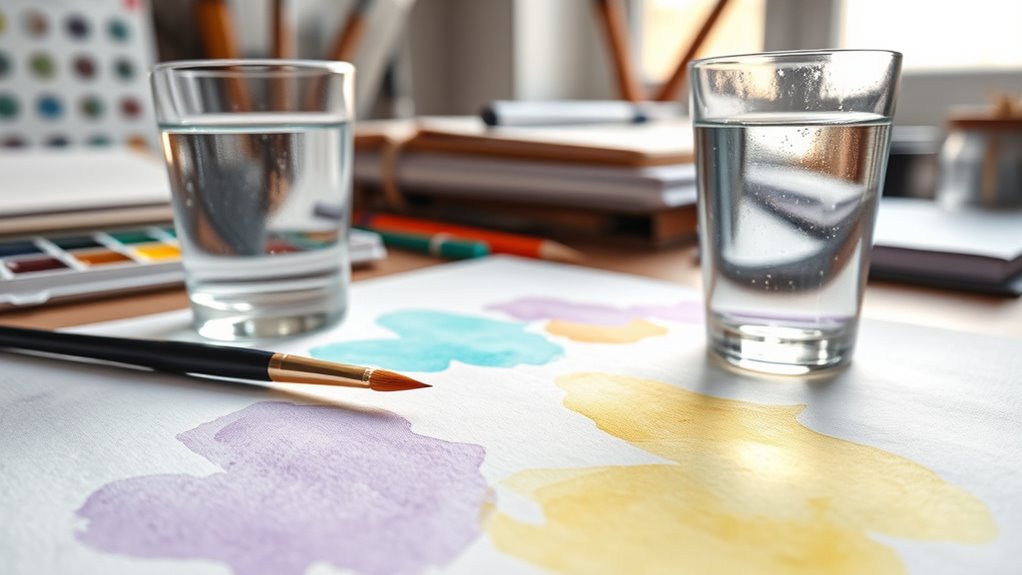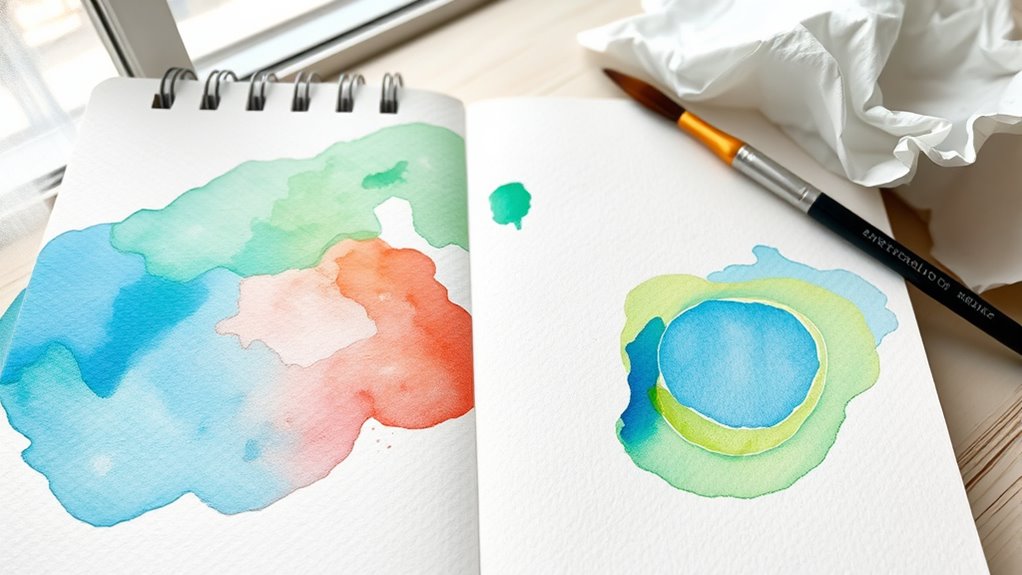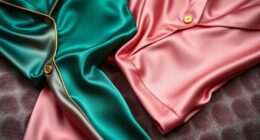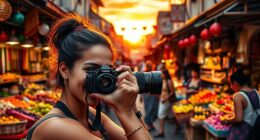As a busy creative, mastering watercolor basics means focusing on quick, effective techniques. Use a limited palette of primary colors to mix vibrant hues easily, and test colors on scrap paper to avoid muddiness. Start with broad washes for backgrounds and layer transparent glazes to add depth without taking too much time. Practice controlling water and brush pressure for faster, cleaner results. Keep these tips in mind, and you’ll discover simple ways to make beautiful watercolor art even on a tight schedule.
Key Takeaways
- Focus on a limited palette of primary colors to quickly mix a wide range of hues.
- Use broad, quick washes to cover large areas efficiently and build layers for depth.
- Practice simple brush techniques like dry brush and smooth washes for faster results.
- Test color mixes on scrap paper to avoid muddy colors and save time during painting.
- Develop confidence with layering and lifting to correct mistakes and add highlights swiftly.

Watercolor painting is a versatile and expressive art form that anyone can learn. Whether you’re creating quick sketches or detailed pieces, understanding the fundamentals helps you make the most of your limited time. One of the first skills to master is color mixing. Unlike other mediums, watercolor relies heavily on how you blend and layer colors to achieve depth and vibrancy. You don’t need a vast palette to get started—start with primary colors and learn to mix them to create a broad range of hues. When mixing, keep your palette clean to avoid muddy colors, and test your mixes on a scrap piece of paper before applying them to your artwork. This habit saves time and prevents unwanted surprises. As you experiment, you’ll discover how different amounts of water affect your colors—more water creates transparency, while less results in richer, more saturated tones. Over time, you’ll develop an instinct for balancing these variables to produce the effects you want efficiently. Developing your color mixing skills is essential for creating vibrant, harmonious paintings quickly.
Another essential aspect is mastering brush techniques. Watercolor brushes come in various shapes and sizes, but a few fundamental techniques can quickly elevate your work. For busy creatives, quick washes are indispensable—using broad, sweeping strokes to lay down background colors or large areas of tone. You can also learn to control the amount of water on your brush to create different textures and effects, such as dry brush strokes for texture or smooth washes for seamless color transitions. Layering is key in watercolor, and practicing how to apply transparent layers without muddying your colors saves time and produces cleaner results. Additionally, understanding how to lift color with a damp brush or sponge allows you to correct mistakes or add highlights efficiently. Practice these techniques in small, quick exercises so you can incorporate them into your projects seamlessly, even when time is tight.
Prioritizing these foundational skills—color mixing and brush techniques—ensures you can work confidently and efficiently. With a little practice, you’ll learn how to manipulate your materials quickly and effectively, making your creative process more enjoyable and less stressful. Remember, the goal isn’t perfection but progress; even simple exercises can boost your skills and speed. As you become more comfortable with how colors blend and how your brushes respond, you’ll find yourself producing beautiful watercolor pieces that reflect your personal style, all while managing your busy schedule. In time, these techniques will become second nature, allowing you to focus more on your artistic vision and less on technical hurdles.
Frequently Asked Questions
What Are the Best Portable Watercolor Supplies for Travel?
For the best portable watercolor supplies, choose a compact palette with a variety of colors that’s easy to carry. Look for travel brushes with a good mix of sizes, preferably with a collapsible or ergonomic design. These tools let you paint on the go without bulk. Keep your supplies lightweight, durable, and ready to use anywhere, so you can capture your creative ideas anytime inspiration strikes during your travels.
How Can I Fix Mistakes in My Watercolor Paintings?
Ever wish you could erase your watercolor mistakes? You can fix them with some clever techniques. Use a damp brush to lift off unwanted color, acting like a gentle eraser. For stubborn errors, apply a touch of color correction with a wet brush or white gouache. To prevent mistakes, plan your composition carefully and work in layers. With patience and practice, you’ll turn errors into beautiful opportunities for creativity.
What Paper Types Work Best for Busy Schedules?
You should choose watercolor pads with smooth or medium textures, as they allow quick, even washes perfect for busy schedules. These pads are portable and come in convenient sizes, making them easy to store and carry. Avoid heavily textured papers that require more time and control. Using quality paper designed for watercolors guarantees your paints blend smoothly and dry evenly, helping you create beautiful art even when you’re short on time.
Are There Quick Watercolor Techniques for Beginners?
You can master quick watercolor techniques with simple methods like quick brush strokes and wet-on-wet techniques, perfect for busy schedules. Don’t worry if you’re pressed for time—these approaches let you create beautiful art fast. Just start with broad, confident strokes and let colors blend naturally on wet paper. Practicing these methods helps you produce vibrant, expressive pieces quickly, so you can enjoy painting without sacrificing your busy day.
How Do I Preserve My Watercolor Artwork Long-Term?
To preserve your watercolor artwork long-term, you should use preservation techniques like framing with UV-protective glass and mounting on acid-free backing. Always choose archival materials to prevent fading and deterioration over time. Store your paintings in a cool, dry place, away from direct sunlight and humidity. Proper framing and archival storage ensure your art stays vibrant and intact for years to come, keeping your creative investment safe.
Conclusion
Now that you’ve grasped the essentials of watercolor, it’s time to embrace your inner artist. Remember, even in a world full of smartphones and instant gratification, patience and practice are your best allies—just like the old masters who spent hours perfecting their craft. Keep experimenting, and don’t be afraid to make mistakes. With each brushstroke, you’re creating something uniquely yours. So, go ahead, channel your inner da Vinci and bring your creative visions to life!










